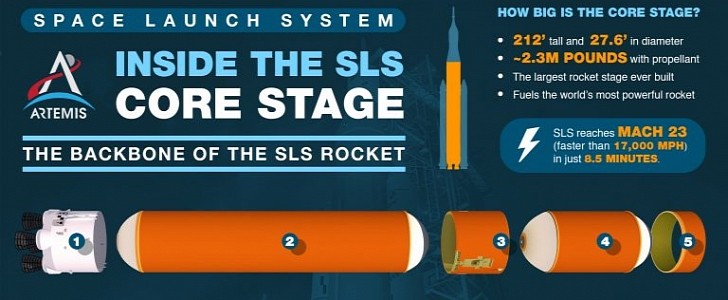Last weekend, the final and most important test for the Space Launch System rocket that will support the Artemis program took place. It was supposed to be an eight-minute firing of all four RS-25 engines of the core stage, but the entire test lasted for just a little over a minute after the engines shut off on their own.
The reasons behind the early abort, if we can call it that, are still under investigation, but NASA says it had enough time since January 16 to assess whether the goals of the test were met. And, at least partially, they seem to have been achieved.
NASA had plans to gather detailed data on 23 objectives and says a number of those, the ones pertaining to activities prior to engine ignition and simultaneous operation of the engines, have been achieved. Unfortunately, no specific details about them are provided.
The SLS is a joint project between Boeing, which handles the manufacturing of the core stage, and Aerojet Rocketdyne, which makes its engines. Both are working with NASA to find out what went wrong; at first glance, it all seems to be the fault of a hydraulic system responsible for the engines giving the rocket the capability to steer.
“On auxiliary power unit 2, we saw a low indication on the hydraulic reservoir level, and the hydraulic pressure. Those two 'low cuts' went through their checks over a series of milliseconds," said John Honeycutt, SLS program manager, according to BBC.
"And on the three checks that it took, it stayed low and it sent the command to the flight computer to advance the shutdown."
The core stage currently being tested is good for another 20 fuel-ups (they use cryogenic fuel for that) before becoming useless. NASA is saving 13 of these fuel-ups (officially called cryogenic loading cycles) for the Artemis program's first mission, scheduled to take off later this year.
If nothing critical is found to be wrong, NASA will use these 13 cycles “for multiple launch attempts, a wet dress rehearsal on the launch pad, and other activities that require propellant loading and tank pressurization.”
NASA had plans to gather detailed data on 23 objectives and says a number of those, the ones pertaining to activities prior to engine ignition and simultaneous operation of the engines, have been achieved. Unfortunately, no specific details about them are provided.
The SLS is a joint project between Boeing, which handles the manufacturing of the core stage, and Aerojet Rocketdyne, which makes its engines. Both are working with NASA to find out what went wrong; at first glance, it all seems to be the fault of a hydraulic system responsible for the engines giving the rocket the capability to steer.
“On auxiliary power unit 2, we saw a low indication on the hydraulic reservoir level, and the hydraulic pressure. Those two 'low cuts' went through their checks over a series of milliseconds," said John Honeycutt, SLS program manager, according to BBC.
"And on the three checks that it took, it stayed low and it sent the command to the flight computer to advance the shutdown."
The core stage currently being tested is good for another 20 fuel-ups (they use cryogenic fuel for that) before becoming useless. NASA is saving 13 of these fuel-ups (officially called cryogenic loading cycles) for the Artemis program's first mission, scheduled to take off later this year.
If nothing critical is found to be wrong, NASA will use these 13 cycles “for multiple launch attempts, a wet dress rehearsal on the launch pad, and other activities that require propellant loading and tank pressurization.”

